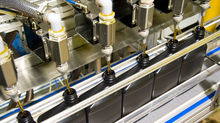Compatibility Pitfalls | Don't Make This Mistake!
Having remanufactured air ends for over 15 years, at our partner facility in Forsyth, Georgia, it is amazing how many air end failures we see as a result of incompatibility. Over the last five years alone, we have found that more than 25% of failures were due to the wrong lubricant being used, incompatibility of mixed fluids, or a lack of lubrication.
Don’t make this mistake...

Incompatibility – Incompatibilities of base stocks are commonly found when switching from a mineral oil to some synthetics. The lubricant can gel or produce a sludge, becoming tacky as in the above photo, and in some cases varnish into a hard resin and coat the internals of the machine, eventually leading to failure. Additive packages can also have compatibility issues causing loss of anti-wear performance, reduction of oxidative stability, and loss of demulsification properties.
Wrong Lubricants & Lack of Lubrication – Use of the wrong lubricant doesn’t always present itself immediately. Too low a viscosity can slowly deteriorate the bearings on a rotary screw compressor, while too high a viscosity can cause operating temperatures to rise. Many reciprocating compressors still run on 30weight non-detergents, but thermal degradation can easily lead to fluid breakdown and development of sludge/carbon, which can be avoided with the use of a diester. A lubricant that doesn’t reach its advertised operating life can cause a failure in any type of compressor.
On-location Compatibility Testing - When switching over to a new lubricant supplier, the most common concern is the potential for compatibility issues. One of the main issues we hear from customers is that they do not know what type of oil they are currently using. We can do a compatibility test on the spot, at your facility to determine what type of oil your air compressor needs. Check out these examples:

Example of Two Compatible Fluids (above) - The two fluids, once mixed, remain clear and bright with no residual film left above the fluid line. The green dye used in one of the fluids has had no significant impact on the fluids compatibility. The bubbles shown in the jar are what’s known as air entrainment. These bubbles will rise to the surface and burst.

Two Incompatible Fluids (above) - Notice that the two fluids which were originally clear and bright, once mixed have become opaque and hazy. The thick and persistent film above the fluid line are also signs of incompatibility.

Incompatibility with Additional Adverse Consequences (above) - The common color and clarity impact can be seen in this example of incompatibility. In addition, the mixture of these two fluids have caused significant foaming to occur. Foaming can result in substantial fluid loss downstream, and cause the compressor's temperature to spike.
Need help troubleshooting a lubricant issue? We can help. Contact us today.
Phone: 904- 723-4946 | Email: info@saperformance.net























